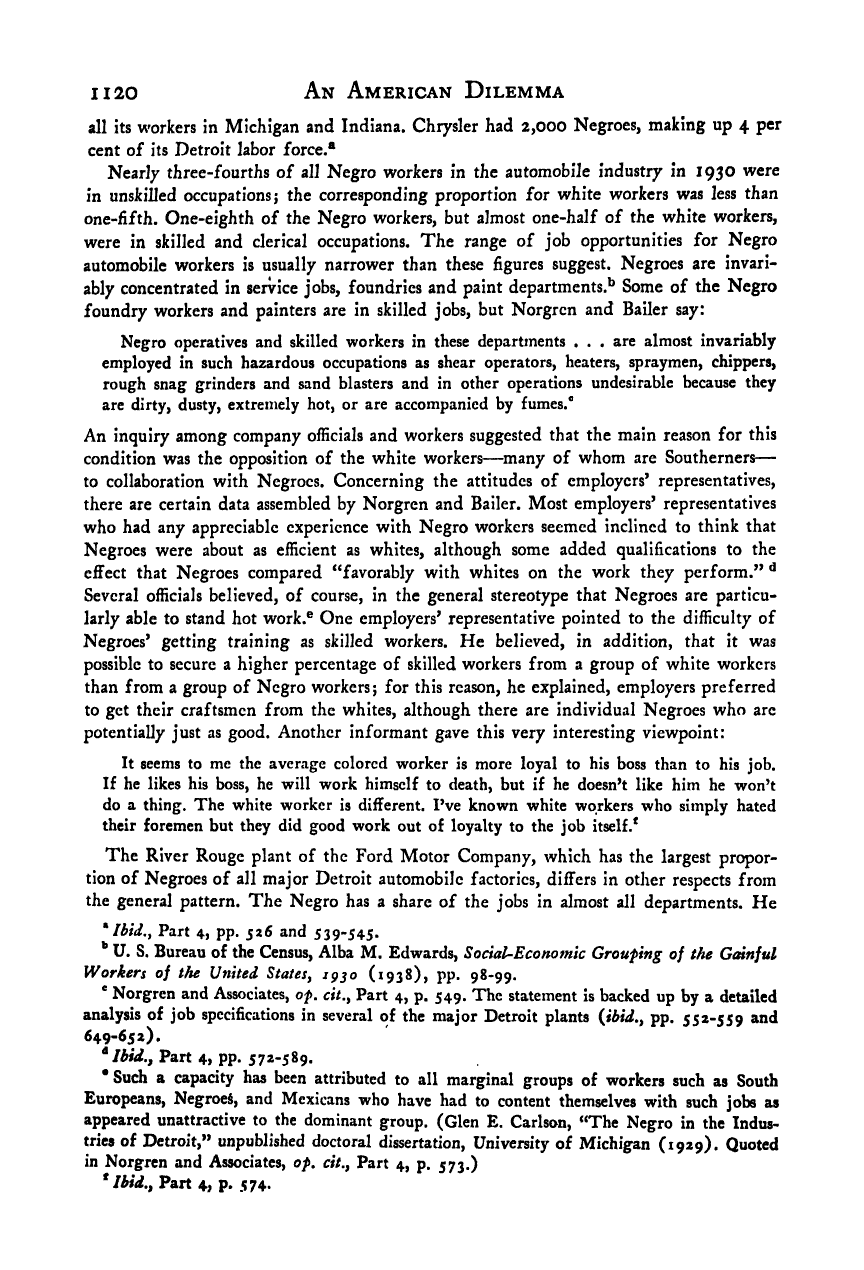Note: Gunnar Myrdal died in 1987, less than 70 years ago. Therefore, this work is protected by copyright, restricting your legal rights to reproduce it. However, you are welcome to view it on screen, as you do now. Read more about copyright.
Full resolution (TIFF) - On this page / på denna sida - Appendices - 6. Pre-War Conditions of the Negro Wage Earner in Selected Industries and Occupations - 14. Automobile Workers

<< prev. page << föreg. sida << >> nästa sida >> next page >>
Below is the raw OCR text
from the above scanned image.
Do you see an error? Proofread the page now!
Här nedan syns maskintolkade texten från faksimilbilden ovan.
Ser du något fel? Korrekturläs sidan nu!
This page has never been proofread. / Denna sida har aldrig korrekturlästs.
1120 An American Dilemma
all its workers in Michigan and Indiana. Chrysler had 2,000 Negroes, making up 4 per
cent of its Detroit labor force.®
Nearly three-fourths of all Negro workers in the automobile industry in 1()$0 were
in unskilled occupations; the corresponding proportion for white workers was less than
one-fifth. One-eighth of the Negro workers, but almost one-half of the white workers,
were in skilled and clerical occupations. The range of job opportunities for Negro
automobile workers is usually narrower than these figures suggest. Negroes are invari-
ably concentrated in service jobs, foundries and paint departments.^ Some of the Negro
foundry workers and painters are in skilled jobs, but Norgrcn and Bailer say:
Negro operatives and skilled workers in these departments . . . are almost invariably
employed in such hazardous occupations as shear operators, heaters, spraymen, chippers,
rough snag grinders and sand blasters and in other operations undesirable because they
are dirty, dusty, extremely hot, or are accompanied by fumes.®
An inquiry among company officials and workers suggested that the main reason for this
condition was the opposition of the white workers—many of whom are Southerners
—
to collaboration with Negroes. Concerning the attitudes of employers’ representatives,
there are certain data assembled by Norgren and Bailer. Most employers’ representatives
who had any appreciable experience with Negro workers seemed inclined to think that
Negroes were about as efficient as whites, although some added qualifications to the
effect that Negroes compared “favorably with whites on the work they perform.” ^
Several officials believed, of course, in the general stereotype that Negroes are particu-
larly able to stand hot work.® One employers’ representative pointed to the difficulty of
Negroes’ getting training as skilled workers. He believed, in addition, that it was
possible to secure a higher percentage of skilled workers from a group of white workers
than from a group of Negro workers; for this reason, he explained, employers preferred
to get their craftsmen from the whites, although there are individual Negroes who are
potentially just as good. Another informant gave this very interesting viewpoint:
It seems to me the average colored worker is more loyal to his boss than to his job.
If he likes his boss, he will work himself to death, but if he doesn’t like him he won’t
do a thing. The white worker is different. I’ve known white workers who simply hated
their foremen but they did good work out of loyalty to the job itself.*
The River Rouge plant of the Ford Motor Company, which has the largest propor-
tion of Negroes of all major Detroit automobile factories, differs in other respects from
the general pattern. The Negro has a share of the jobs in almost all departments. He
* Ihid.y Part 4, pp. 526 and 539-545.
**
U. S. Bureau of the Census, Alba M. Edwards, Social-Economic Groufing of the Gainful
Workers of the United States^ 1930 (1938), pp. 98*99.
* Norgren and Associates, of, cit.y Part 4, p. 549. The statement is backed up by a detailed
analysis of job specifications in several of the major Detroit plants {ibid,y pp. 552-559 and
649-652),
Part 4, pp. 572-589.
* Such a capacity has been attributed to all marginal groups of workers such as South
Europeans, Negroes, and Mexicans who have had to content themselves with such jobs as
appeared unattractive to the dominant group. (Glen E. Carlson, “The Negro in the Indus-
tries of Detroit,” unpublished doctoral dissertation. University of Michigan (1929). Quoted
in Norgren and Associates, of, cit.y Part 4, p. 573.)
^ Ibid.y Part 4> P* 574-
<< prev. page << föreg. sida << >> nästa sida >> next page >>